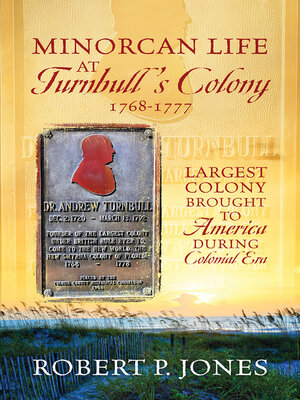Minorcan Life at Turnbull's Colony 1768-1777
ebook ∣ Largest colony brought to America during colonial era
By Robert P. Jones

Sign up to save your library
With an OverDrive account, you can save your favorite libraries for at-a-glance information about availability. Find out more about OverDrive accounts.
Find this title in Libby, the library reading app by OverDrive.



Search for a digital library with this title
Title found at these libraries:
| Library Name | Distance |
|---|---|
| Loading... |
With the stroke of a pen, Britain acquired approximately 34 million acres of land in 1763—territory that had been Spain's La Florida since 1565. Trade was the economic engine of the time, and the cost of imported goods was rising. There was a chance that certain goods—especially indigo, which was already scarce and expensive in Britain—could become more readily available from Dr. Andrew Turnbull's New Smyrna colony.
This book provides background on the challenges the Minorcans faced during their nine years of living and working under harsh conditions at the Turnbull colony. This account is based on the James Grant Papers, courtesy of the Dundee City Archives in Scotland.
The letters serve as the primary source material, written by the British with scarcely a mention of the Minorcan indentured servants who labored for nine grueling years under harsh and often pitiless conditions. A complete account of the Minorcans' experiences may never be known—no personal letters from them have survived. What remains are sworn depositions that document their mistreatment at the Turnbull colony from 1768 through most of 1777.
This narrative seeks to raise awareness of the Minorcans as a resilient and distinct cultural group whose legacy deserves recognition. It is hoped that one day, an organization or institution will locate at least one of the 964 Minorcan graves believed to lie beneath the soil of New Smyrna Beach, Florida. The discovery of even a single grave—perhaps leading to others—would stand as a powerful act of remembrance and respect for the "Missing Minorcans."
The site of San Pedro Church is located on North Riverside Drive in New Smyrna Beach. It was on this sacred ground that Father Pedro Camps and Father Bartolomé Casanovas led the Catholic faithful, who made up the majority of the colonists. The New Smyrna Museum of History highlights the location of San Pedro Church in their latest pamphlet.
The Minorcans labored tirelessly in the struggling colony. In 1777, they walked from New Smyrna to St. Augustine, where many families have remained ever since. Their culture, language, cuisine, and traditions have not only endured but have helped shape the rich heritage of the region to this day.
Their contributions to the history of St. Augustine, to Florida, and to the nation are too significant to go unrecognized. It is hoped that this book brings to life what daily existence on the Turnbull colony was like during those nine long years—for a people whose resilience still echoes through history.







